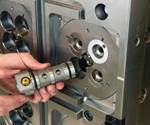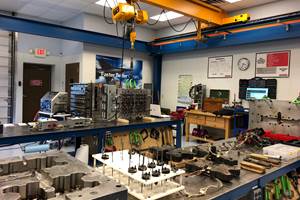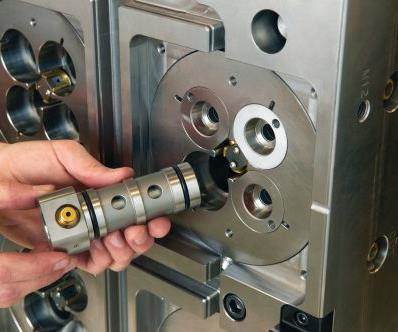In the Trenches: Shaving with Occam’s Razor
“How often have I said to you that when you have eliminated the impossible, whatever remains, however improbable, must be the truth?” Occam’s Razor
This little line that looked to be cut from a newspaper was scotch taped to the wall in the toolroom. I always found it interesting in its own right, but never really gave much thought as to why it was there. Perhaps whoever posted it there dealt with the same conundrums that I deal with everyday. Namely, “What caused this damage?” or even more irritating, “What is causing this part defect?” Maybe you’ve heard of Occam’s Razor, maybe you haven’t. A little internet search yielded more technically accurate phrasings of the Razor than the colloquial version to which I was first introduced.
Unfortunately the more technical rendering is less conducive to the point I’d like to emphasize than I’d hoped. Regardless, I’ll take some license and use the watered down version, which came as chance would have it, from a Sherlock Holmes novel.
The rather more irritating question above is the one that perplexed me recently. The tool has two sub-slide cores that form screw bosses on the inside of a horse-shoe shaped part. For reasons incomprehensible to me the features in the sub slides were burned in the solid—i.e. the hole that makes the boss and the core that makes the hole in the boss are all the same piece of steel. (Obviously, the designer didn’t read my Designed for Maintainability article, MMT, October 2012; The fact that the mold was built years before the article is a mitigating factor, but still).
The core that forms the hole in the screw boss broke!!! Imagine that! So to repair it—as necessity dictates in a minimally equipped in-house toolroom—we had to drill and ream then tap the counterbore to install a small core pin with a set screw behind the head in the slide core. All went pretty well. That is, until we ran parts.
The core—that for all intents and purposes looked like and measured like the undamaged original on the other side of the part—rendered parts with a significant sink on the appearance surface.
Well, since sink is caused by excess shrink where material is thicker than the surrounding section, a second attempt was to make the core pin with a little less draft (to make the end of the pin larger) and slightly longer. Both measures intended to reduce the amount of material available to shrink. You guessed it, we still had shrink.
Third attempt. Well, let’s back up a minute. The first attempt was a pretty straight-forward approach of replicating as closely as possible what was originally there, at least dimensionally. Never thinking that there would be any possible adverse effects to deal with, it never crossed my mind to do anything more costly or complicated. It came as a surprise that the parts had a defect.
Now rather than compiling failures, let’s build on success. The first attempt was 100 percent successful. What? The goal was to replace the steel that had been damaged, did we do that? Yes. Was it true to the original dimensional requirements? Yes. Objective met. OK so the second attempt was really the first attempt of a different mission. The mission being to address a part defect rather than to repair mold damage.
Knowing what is commonly known about sink—the defect we appeared to have—that uneven section thicknesses result in uneven shrink, and consequently irregular part surfaces, the logical course of action was to reduce the thick material condition. Doing this by increasing the tip diameter of the core and increasing the length of the core were perfectly reasonable courses of action. Either one may have been an adequate remedy, so I figured let’s do both and we’re sure to hit a homerun. But alas, as I said, that was not the case.
Now we’re at the point of making a second attempt to correct a part defect, or more correctly, we’re at the point of our first failure—the event that should stop you in your tracks, make you start asking questions and doubt your assumptions, then re-evaluate the problem from a different perspective.
After shaking our heads and pushing past the tinge of disbelief, that is what we did. We being the toolroom staff and the processors.
In the toolroom we asked, “What is different?” We had assumed that we had replicated the undamaged tooling. And “What other factors affect or cause sink?” The assumption was that section thickness is totally, solely responsible for sink. The answers to these questions comingled to provide the next attempt at solving the puzzle.
We noted at least two differences: the repair was a two-piece assembly as opposed to a single-piece core, and there was slight fingernail flash around the core pin, so we knew we did not have a perfectly round hole.
The answer to the second question (What other conditions affect sink? Cooling) led to another question: “Could heat transfer/dissipation have something to do with the defect?” Is it possible that the two-piece configuration dissipated heat differently—differently enough that it might induce the sink we were seeing? With the less-than-perfectly round hole, it was conceivable that heat was not dissipating as effectively as it would in a solid construction scenario.
Also we did a quick check with gage pins to assess the concentricity of the pin to the boss (not a good method, but quick; actually not good at all when checking a drafted pin in a drafted boss) and found only a couple thousandths difference. Which we interpreted as a dead end (such was not the case).
The processers gave considerable time and effort trying to tweak the process, but came up empty-handed. When every adjustment known to affect a sink doesn’t fix the problem, good sense tells you it’s probably not sink. If not sink, the only other thing it could be was that the retracting action of the slide had to be pulling the material, giving the appearance of a sink.
They (the process engineers) even went so far as to experiment with prolonged cooling times up to 3 minutes. The defect was consistent. You could allow that hot material could be pulled out of shape in a normal cycle, but after being cooled for 3 minutes you would expect the material to be fully set and incapable of being pulled out of shape. Further, if in fact it was being “pulled,” there would be signs of dragging or deformation on the boss feature. None was apparent.
So, we had a two-piece construction with a less than round hole, possible heat dissipation issue and a verdict from processing that it was probably not sink.
To be continued …
Related Content
Precision Meets Innovation at IMTS 2024
After attending IMTS, it's clear that the integration of advanced technologies is ready to enhance precision, efficiency and automation in mold manufacturing processes. It’s a massive event, so here’s a glimpse of what the MMT team experienced firsthand.
Read MoreWhat You Need to Know About Hot Runner Systems and How to Optimize Their Performance
How to make the most out of the hot runner design, function and performance.
Read MoreWhat is Scientific Maintenance? Part 2
Part two of this three-part series explains specific data that toolrooms must collect, analyze and use to truly advance to a scientific maintenance culture where you can measure real data and drive decisions.
Read MoreHands-on Workshop Teaches Mold Maintenance Process
Intensive workshop teaches the process of mold maintenance to help put an end to the firefighting culture of many toolrooms.
Read MoreRead Next
In the Trenches: Mold Repair
In this multi-part series of articles, contributer James Bourne, a tool repair supervisor and freelance writer, shares his own personal struggles in the business, as well as lessons learned and tricks of the trade garnered along the way.
Read MoreHow to Use Continuing Education to Remain Competitive in Moldmaking
Continued training helps moldmakers make tooling decisions and properly use the latest cutting tool to efficiently machine high-quality molds.
Read MoreReasons to Use Fiber Lasers for Mold Cleaning
Fiber lasers offer a simplicity, speed, control and portability, minimizing mold cleaning risks.
Read More





















